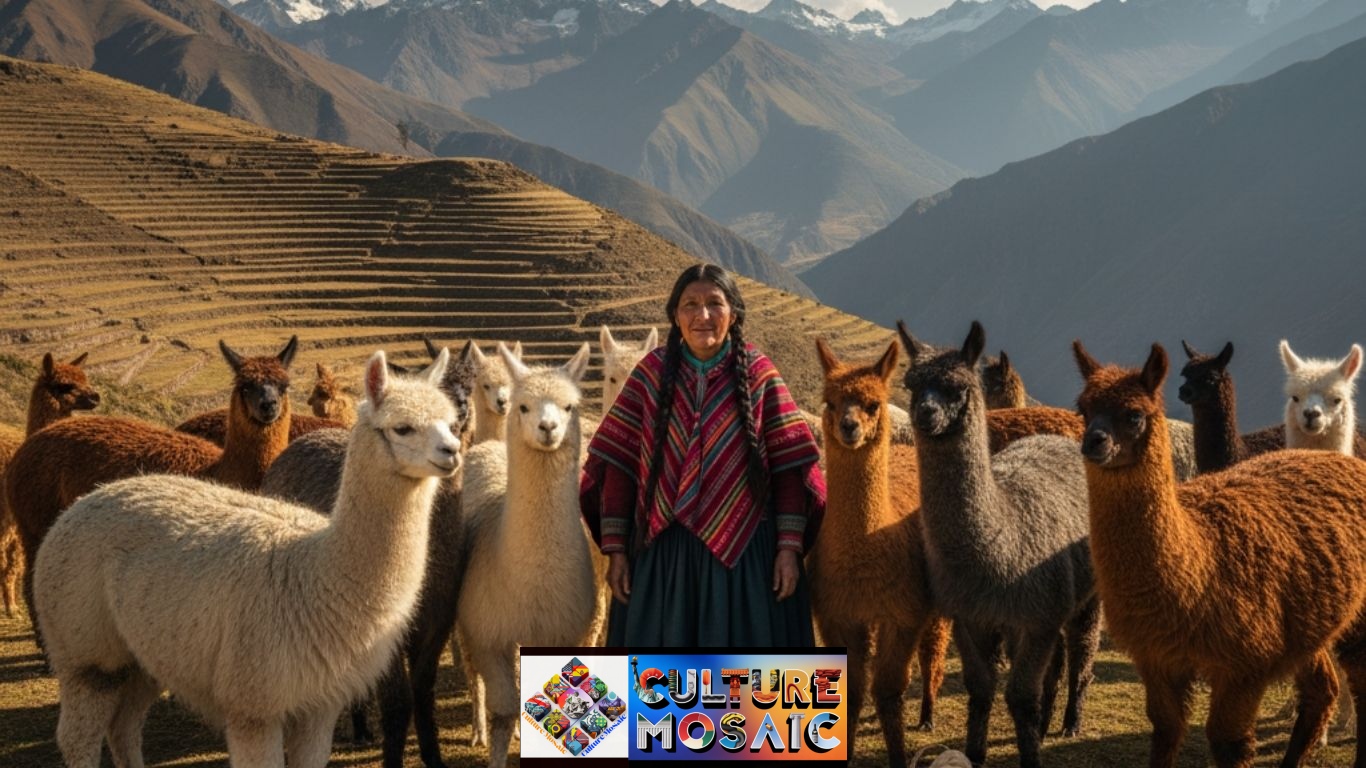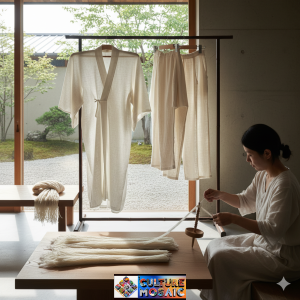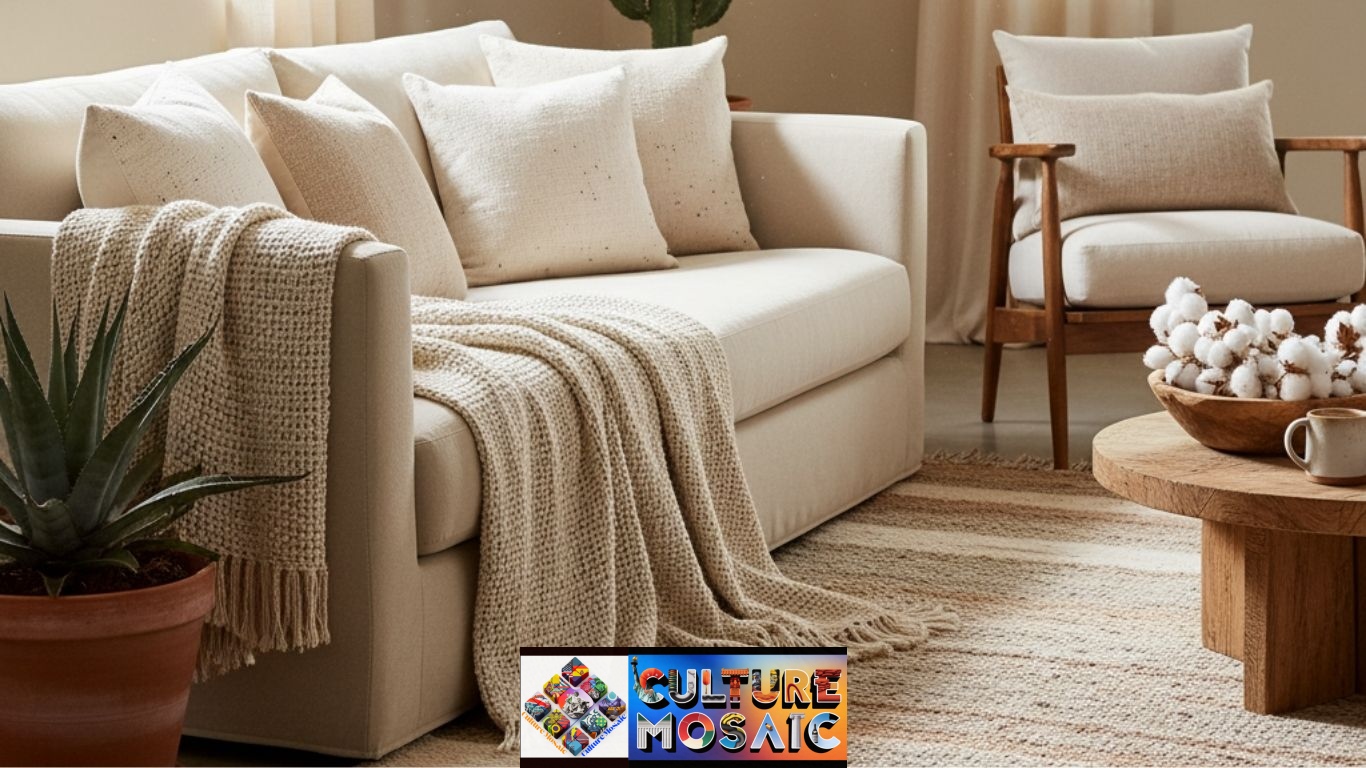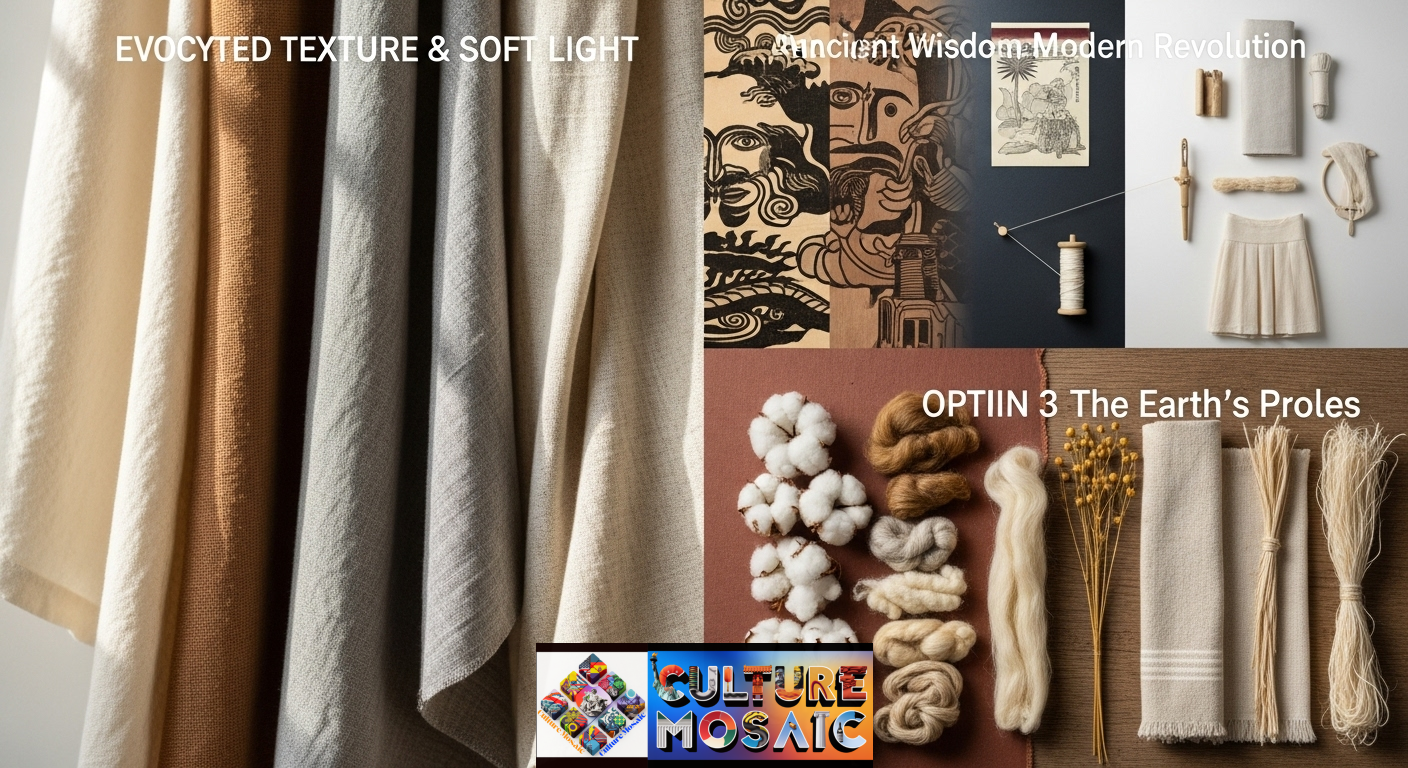Right now, there is something quietly radical in fashion. While the runway has cycled through neon brights and saturated jewel tones, a growing movement is taking things back to the basics – literally. We are talking about undyed textiles, those beautiful natural colors that have not seen a single drop of chemical dye.
However, there is one important point to consider: this is not a new trend influenced by Instagram. The concept of undivided aesthetics has existed for thousands of years and is woven into the cultural fabrics of various continents. Keeping clothing in its natural state and utilizing raw materials, such as the remmi fibers produced by Japanese artisans or the specific wool colors bred from alpacas by Andean shepherds, reflects the original sustainable fashion statement.
What Exactly Are Undyed Textiles?
First, let’s clarify our topic. When we refer to undyed clothes, we are discussing materials that retain their natural color from the source, without the use of synthetic dyes, chemical baths, or any color manipulation.
Consider the creamy beige of raw cotton, the soft brown of natural alpaca wool, or the gentle gray of unbleached linen. These colors are not “boring”; they showcase the diverse palette of nature rather than act as a branding tool. Each fiber possesses subtle variations in tone, creating depth and character that synthetic dyes cannot replicate.
The beauty of undivided materials lies in their honesty. What you see is literally what you get, and this authenticity echoes with people who are tired of artificial and excessive processing..
The Ancient Andean Masters of Natural Color

Indigenous communities in the mountains of Peru and Bolivia have been perfecting the art of working with undyed wool for over 5,000 years. They didn’t simply accept the natural colors produced by their alpacas; instead, they became master breeders, carefully cultivating specific animals for desired natural colors.
Traditional Andean shepherds can produce alpaca wool in more than 22 naturally occurring colors, ranging from pure white to deep charcoal black, with a variety of shades of brown in between. This diversity is not a result of chance; it is the outcome of careful breeding over generations, a deep understanding of genetics (even if not labeled as such), and a profound respect for the animals themselves.
These communities never required chemical colors because they would essentially form a living color palette. Each shed had cultural significance, which was used for specific clothing or formal purposes. The dark brown can be reserved for brown clothing, while the ancient white was saved for specialized ceremonies.
Today, contemporary designers are rediscovering these heritage practices. The undyed alpaca wool market is experiencing a Renaissance, highlighting natural color variations as a luxury feature rather than one among fashion brands.
Japanese Minimalism: The Art of Raw Ramie

On the other side of the world, Japan developed its own philosophy around unspecified garments, especially with Remy, a flower plant that produces strong, shiny fibers.
Traditional Japanese Remi processing primarily focuses on producing cloth. Artisans hand-spin the fiber, creating garments with an organic texture and a natural off-white color that almost glows. Unexy Remi retains a subtle brightness and softens over time, embodying the Japanese concept of “Wabi-Sabi,” which appreciates beauty in complexity and imperfection.
Unlike cotton, ramie possesses natural antibacterial properties and exceptional breathability. Highlighting the inherent elegance of the fiber, it retains these functional benefits while offering a unique charm. Japanese garments made from ramie have been worn for centuries, particularly in summer clothing, where its cooling properties truly excel.
Contemporary Japanese designers continue this tradition by creating minimal pieces that allow the natural ramie to speak for itself. There is no need for embellishments when the clothing itself tells a story that spans thousands of years.
Why Raw Cotton Is Having Its Moment

Cotton is a common material, but true raw, undyed cotton has become surprisingly rare in our over-processed world. Raw cotton retains its natural creamy or light tan color and features small flecks of plant material that add character and texture.
The Industrial Revolution brought about the practice of bleaching cotton white before dyeing it in vibrant colors. However, this process can be harmful to the environment because it involves the use of chlorine, caustic soda, and large amounts of water. By choosing to keep cotton undyed, we can avoid these harmful steps, reducing water consumption by up to 70% and eliminating the use of harmful chemicals.
Undyed cotton goes beyond sustainability; it simply feels different. It’s softer, more breathable, and hypoallergenic—ideal for sensitive skin. The natural oils remain in the fiber, providing a subtle suppleness that over-processed cotton lacks.
Interior designers are especially enthusiastic about undyed cotton textiles. These neutral, earthy tones complement virtually any aesthetic, from Scandinavian hygge to desert modernism. Additionally, since the color is natural to the fiber, it won’t fade or lose its vibrancy over time.
The Environmental Case for Going Undyed
Here’s where things get serious. The fashion industry is the second-largest polluter of clean water globally, and textile dyeing is a massive contributor to that problem.
Traditional dyeing processes release toxic chemicals into waterways, including heavy metals such as lead and mercury, formaldehyde, and aromatic solvents that harm aquatic ecosystems. In countries like China, India, and Bangladesh, rivers have changed color based on current fashion trends.
Choosing undyed textiles bypasses this entire toxic cycle. No dye chemicals means no dye waste, no polluted water, no factory workers exposed to carcinogens. It’s one of the simplest ways to make fashion genuinely cleaner.
The carbon footprint difference is equally striking. Dyeing requires heating massive vats of water—often to near-boiling temperatures—then cooling them down again. That energy consumption adds up fast. Undyed production eliminates these energy-intensive steps, significantly reducing the garment’s overall environmental impact.
Plus, undyed textiles are much easier to recycle. When fabrics contain dyes (especially synthetic ones), the recycling process becomes complicated and sometimes impossible. Natural, undyed fibers can be broken down and repurposed without special treatments.
Quiet Luxury Meets Zero-Waste Philosophy
There’s a reason undyed aesthetics align so perfectly with the current “quiet luxury” movement. Both reject flashiness in favor of subtle quality, craftsmanship you can feel rather than see.
When you wear an undyed linen shirt or carry a natural cotton bag, you’re making a statement—just a different kind. You’re saying you value authenticity over artifice, sustainability over trends, longevity over disposability. That’s a luxury in our hyperconsumptive world.
The zero-waste community has embraced undyed textiles with similar enthusiasm. These fabrics align perfectly with principles of reducing consumption, choosing natural materials, and minimizing environmental harm. An undyed wool sweater biodegrades completely at the end of its life, unlike its chemically-treated counterpart.
Fashion influencers are catching on, too. The “clean girl” aesthetic—that effortlessly pulled-together look built on neutral tones and minimal styling—often features undyed pieces. It’s not about looking wealthy; it’s about looking thoughtful.
Caring for Your Undyed Treasures
Natural, undyed textiles need slightly different care than their dyed cousins, but nothing complicated. The main principle? Gentleness is good.
Wash undyed items in cool or lukewarm water with mild, plant-based detergents. Skip the harsh chemicals—you’ve already avoided them in production, so don’t add them during care. Undyed fabrics often maintain their natural oils, which help repel dirt anyway.
Sun exposure can gradually change natural colors over time, just as it would affect living plants or animals. This isn’t damage—it’s evolution. Many people love how undyed linen develops character as it ages, with certain areas softening in color while others deepen.
For undyed wool, proper storage is crucial. Cedar blocks work beautifully (and naturally) to deter moths without chemical mothballs. The wool’s natural lanolin provides some protection, but a little extra care preserves these pieces for decades.
How to Incorporate Undyed Into Your Life
Starting with undyed doesn’t mean throwing out your entire wardrobe. Begin with basics—the items you wear most often and wash frequently.
Undyed cotton t-shirts, linen bedding, or wool socks are perfect entry points. These everyday essentials benefit most from being chemical-free, especially items that touch your skin constantly. You’ll likely notice the difference in comfort immediately.
For home textiles, undyed options are everywhere now. Natural cotton towels, linen curtains, wool blankets—these pieces add warmth and texture to any space while keeping your home environment cleaner. The neutral tones work as a foundation that lets you layer in color through art, plants, or the occasional dyed accent piece.
When shopping for undyed items, look for transparent brands that specify their sourcing and production methods. Terms like “natural color,” “raw,” “unbleached,” or “undyed” should appear in the product description. Don’t be afraid to ask questions—brands proud of their undyed practices love talking about them.
The Future Is Looking Naturally Neutral
The undyed movement is gaining momentum, but it’s not about replacing all dyed textiles. Instead, it’s about bringing balance back to fashion and recognizing that sometimes the most innovative choice is the oldest one.
Young designers are experimenting with mixing undyed and naturally dyed pieces (using plants, minerals, and other non-toxic sources). This approach celebrates color while respecting both human health and environmental limits.
Technology is helping too. New processing methods are making undyed textiles more accessible and affordable without compromising their natural integrity. As demand grows, prices drop, making these options realistic for more people.
What’s particularly exciting is how undyed textiles are helping us reconnect with the origins of our clothing. When you wear undyed alpaca wool, you’re taking part in a tradition that spans 5,000 years. That gray linen shirt connects you to ancient craftspeople who recognized that nature’s palette was already perfect.
Undyed as Resistance
In a world that constantly demands novelty, brightness, and excess, choosing undyed feels almost countercultural. It’s a subtle rejection of the notion that everything requires enhancement, processing, or improvement. Indigenous communities that preserved undyed traditions did so not only out of necessity but also out of wisdom. They recognized that working with nature, rather than against it, resulted in more beautiful, durable, and meaningful outcomes.
We are finally beginning to understand what some have recognized from the start: sometimes, the most revolutionary approach is to simply leave things as they are. Allow cotton to be cotton and wool to be wool. Trust that the natural world had its own wisdom before we began to interfere.
The undyed revolution isn’t asking you to live like our ancestors; it’s inviting you to learn from their wisdom. It encourages us to view neutral colors not as dull options, but as purposeful choices. In fashion, as in life, embracing less processing often leads to greater authenticity.
The creamy, undyed cotton shirt hanging in your closet is more than just a piece of clothing. It represents a connection to ancient traditions, supports cleaner water, and serves as a small rebellion against overconsumption. Not too bad for a simple piece of fabric that has been left untouched.
FAQs
Do undye fabrics come in different colors, or are they all beige?
Actually, undye textiles offer a surprising variety! Natural cotton ranges from cream to light tan, linen can be anywhere from pale grey to golden beige, hemp has greenish undertones, and wool comes in white, grey, brown, and black, depending on the animal breed. Alpaca alone provides over 22 naturally occurring shades. The key is that these colors come from the fiber itself, not from dyes.
Are undyed clothes more expensive than regular clothing?
It depends. Undye textiles skip the dyeing process, which should theoretically make them cheaper. However, many undyed pieces come from smaller, ethical producers focused on quality and sustainability, which can increase prices. Mass-market undyed basics (like unbleached cotton t-shirts) are often very affordable, while heritage undyed alpaca or handspun ramie commands premium prices due to craftsmanship. Overall, you’ll find options at various price points.
Will undyed fabrics stain or discolor more easily?
Not necessarily. Many undyed natural fibers actually resist staining quite well because they retain their natural oils and structure. Undyedwool has lanolin that repels dirt, while undyed cotton’s texture can hide minor marks better than stark white fabric. That said, light-colored undyed items may show stains more visibly than dark dyed fabrics, but they’re often easier to clean since you don’t have to worry about preserving dye color.
Can I still have colorful clothing if I care about sustainability?
Absolutely! The undye movement isn’t about eliminating all color—it’s about being thoughtful. Natural dyes made from plants, minerals, and insects have been used safely for millennia and are experiencing a revival. Combining undyed basics with naturally dyed accent pieces gives you color without the toxic chemicals. Some people build wardrobes around undyed neutrals as a foundation, then add carefully chosen dyed items.
How can I tell if something is truly undye or just dyed to look natural?
Look for specific language: “undyed,” “natural color,” “raw,” or “unbleached.” Check if the brand provides transparency about their process—reputable producers are proud to explain their methods. Truly undyed items often have slight color variations from piece to piece (since natural fibers vary), while something dyed to look beige will be perfectly uniform. When in doubt, contact the brand directly and ask about their dyeing process.

